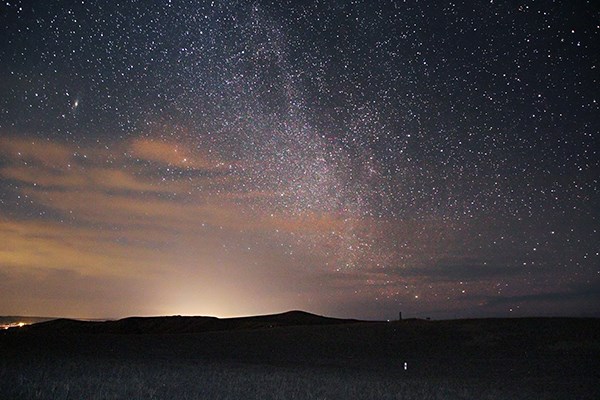
NPS Brandon Blackburn National parks preserve some of the darkest skies in the country. In some areas, it's possible to see up to 15,000 stars throughout the night. By contrast, fewer than 500 stars may be visible from more urban environments. What many people don't realize is that light pollution affects more than just astronomers. Nocturnal animals need darkness for survival, and the circadian rhythms of humans and plants rely on an unaltered night sky. Though light pollution is created by a multitude of lights, this problem can be resolved one light at a time. When an outdoor light burns out, consider it an opportunity to install a lower intensity bulb or replace the fixture with one that is more night-friendly. Shielding that directs light downward produces less glare and improves security.
"There are certain values in our landscape that ought to be sustained against destruction or impairment, though their worth cannot be expressed in money terms. They are essential to our "life, liberty, and pursuit of happiness" this Nation of ours is not so rich it can afford to lose them; it is still rich enough to afford to preserve them." —Newton B. Drury, Director NPS 1940–1951 
Native American Prayer. NPS Night Sky photos Night Skies as a Cultural and Historical ResourceThroughout history the night sky has shaped the beliefs and traditions of Many Native Americans. The tradition of Cultural Astronomy continues today.To the Crow all the stars are sacred. Within their cosmogony and cosmology, however, there are constellations that have special religious interpretation and history. One constellation that is always prominent in their lifeways is the Big Dipper. It is Ihka Sa'hpua, "Seven Stars" and also Iipchalapaachuoo, "The Place Where The Pipe Is Pointed." This constellation is also the place where the "Seven Sacred Brothers," Akbuchaku'pe Sa'hpua, the "Seven Sacred Bulls," Bishe'e Chiilape Sa'hpua, and the "Seven Sacred Rams," Iisaxpu'atahche Sa'hpua reside. The Stars We Know Crow Indian Astronomy & Lifeways Timothy P. McCleary The Sioux call the Milky Way "The Place of Spirits", Wanagi Yata, which is somewhere in the southwestern sky world. To the newly arrived spirit, Wanagi Yata is first of all a place of happy reunion with deceased relatives and friends. Life continues there. A circle of tipis, ceremonial singing and social dancing, plenty of food and water shared with peaceful and respected relatives characterizes Wanagi Yata. Only the obessions, the insults and injuries of the early life are absent there. Lakota Star Knowledge Studies in Lakota Stellar Theology Ronald Goodmen To the Cheyenne, The Hanging Road (Milky Way) is the path along which spirits travel to the afterlife. The Morning Star and Evening Star merit particular esteem because of their brilliance in the heavens in the heavens and their proximity to the sun and moon. Stars of the First People Native American Star Myths and Constellations Dorcas S. Miller Starry night skies and natural darkness are important components of the special places the National Park Service protects. National parks hold some of the remaining harbors of darkness and provide an excellent opportunity for the public to experience this endangered resource. The NPS is dedicated to protect and sharing this resource for the enjoyment of current and future generations. For more information about the night sky and what the National Park Service is doing to protect it visit the Natural Sounds and Night Sky Division or NPS Night Skies.
Use NASA's Spot the Station app to receive notifications when the International Space Station is visible. |
Last updated: July 3, 2025
